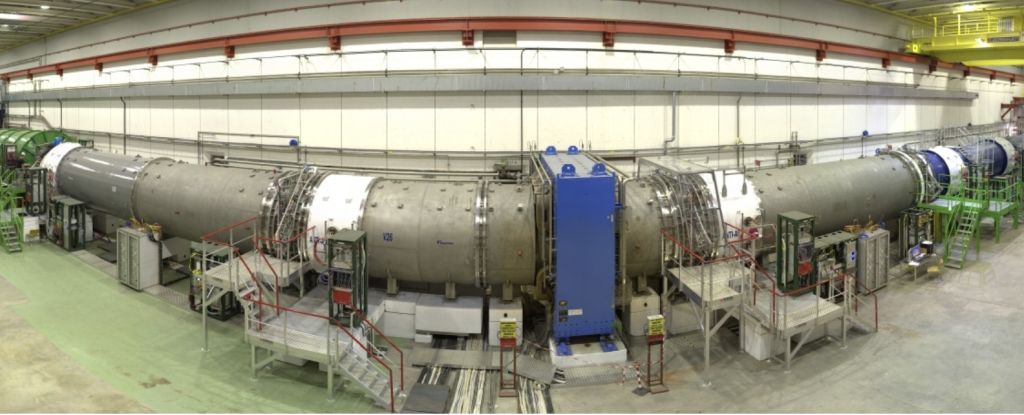Are we heading toward spicy physics or extra crispy physics?
D E E P - F R I E D
chunky
So the Sophons have finally arrived.
I tried reading, then simply skimming, but this is over my head and I didn’t think I could get through it comfortably. I was hoping for a paragraph that summed up a simple explanation, but if there was one, it was further in than I got. Can anyone summarize for dummies what this means for our understanding of physics?
There’s a particular particle, the kaon, which can be created. This particle is highly unstable, and so, decays rapidly into other particles. Ever so often, it doesn’t decay down the normal route but instead decays into a pion. This is extremely rare (6 in a billion).
In physics, we have what’s called the “standard model”. It’s our best guess as to how physics works at the fundamental level. It’s incomplete, however, with multiple slight variations. This decay pathway is interesting because it is quite sensitive to differences between these models. By measuring the energy and ratio of the resulting mess, we can disguard some variants of the model (their predicted energy is too high or too low).
By using a large number of little measurements, like this, scientists can home in on the most accurate “standard model” variant. This, in turn, informs work on a deeper understanding of physics.
Basically, a decade’s work to put a single new point onto a graph. A point that onky theoretical physicists care about, and might, or might not be useful down the line. Welcome to modern physics.
It’s just the creation of particles with an ultra-short lifespan, which then decay into other particles. Only there are more of this type than expected, but still within the tolerance of what the theory predicts. Additional tests are needed to say anything conclusive. That’s just what they normally like to do at CERN, they’re quite good at it. They also started the world wide web, back in the day.
Thanks!
will this discovery make it easier for me to get isekai’d into another world where I’m the hero that’s going to save the world with my big d magic skillz?
new physics dlc about to drop?? poggers
Yeah but how much is it? Is it only for premium members?
It ain’t cheap but it’s worth every penny
I assume the scientists got a sense of pride and accomplishment from this.
Announcing the Horace-Armour particle!
Is this a physics 2.0 kind of thing? Or just a small patch?
It’s nothing that would upend the Standard Model, but would define some new interactions and processes.
Phew, I feared I had to learn new physics. I already struggled with the old one.
I haven’t even caught up with old physics, slow down, people.
irately:
physics is physics!!!
Finally… Science 2
Science 2: Electroweak Boogaloo
I REALLY need to finally sit down and watch this damn movie.
Huh.
I thought it started with the Pikachu thing. TIL.
Science journalism try to be accurate and non-clickbait mission impossible

The number of kaon to pion and neutrino/antineutrino decays the team observed is higher than the 8.4 per 100 billion predicted by the Standard Model, but it’s still within the uncertainty parameters.
So then how the fuck does that hint at new physics? Idiots.
The basic procedure at CERN is that in order to be certain about something that’s super random is to conduct the experiment trillions of times until you get a couple thousand events and you get to beat down your error. If they startseeing something, it’ll still take them a couple of years of data to prove it past their uncertainty requirements.
Whatever particle physicists are, idiots they’re not
It’s a HINT, not a certainty 😘
They demonstrated the event to five sigma certainty, which is significant, but it’s within the uncertainty in the standard model. If they can demonstrate the same or similar things to greater exactness, it could guide research that changes the standard model
“Ultra-rare” means
The number of kaon to pion and neutrino/antineutrino decays the team observed is higher than the 8.4 per 100 billion predicted by the Standard Model, but it’s still within the uncertainty parameters.
CERN confirms ultra-rare particle transformation.
Three Body Problem:
Scientists commit suicide.IRL:
Scientists get super stoked about “new physics”.Wasn’t the whole thing about the scientists in the Three Body Problem that they recognised that their work was being sabotaged by something enormously more powerful?
No. The scientists do not figure out that things are being meddled with until much later. The scientist suicides, especially the daughter of the woman who invites the aliens, committed suicide because everything they knew about physics had been “proven incorrect”. It was all a lie, but they didn’t know that.
Ahh my mistake
Actually, I think your take would have made more sense. It never sat well with me that scientists would resort to suicide because they found something they could not explain…yet.
Maybe that’s why I misremembered it. I agree, it does seem like the exact opposite to what scientists actually do upon finding something they can’t explain
“…all of Physics is wrong!”








